Mixborders: ideas in landscape design
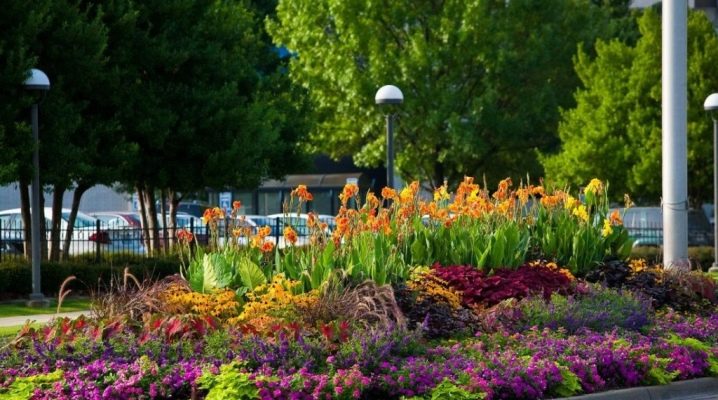
Isn't it true that once you, after waiting for flowering in the garden, came to the conclusion that the plants were planted in a hurry, and therefore they look unkempt, sloppy? Immediately there is a desire to ask them some spectacular layout program. It is for this purpose that a mixborder serves - a mixed flower garden. We offer you to figure out how to make it yourself.

What it is?
If you literally translate "mixborder" from English, you get "mixed border". After the adaptation of the concepts, the foreign word began to mean an arbitrary flower garden, made up of different groups of plants, thought out according to the time of flowering and the harmony of shades.
A mixborder can be considered a distant "relative" of a rabatka - flower beds in the form of a bed. But the similarities end at the elongated configuration. The rabatka uses a geometric pattern of flowers (stars, squares, circles). And the mixborder has "floating" lines, soft curves that define the landscape style of the flower garden. The mixborder is organized outwardly unobtrusively, sometimes it seems as if a lovely natural scattering of flowers by itself so successfully picked up the right palette and ennobled the lawn or area near the house.
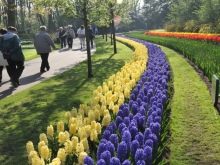
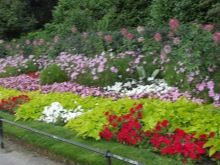
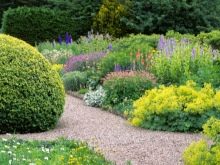
The popularity of mixborders is due to the relative ease of color selection. Even a beginner in gardening can afford to create such a bed. Of course, growing everything in a flower bed is not good. It is necessary to study the rules for selecting plants for a floristic collection.
By the way, in addition to flowers, shrubs and vines are added to mixborders.
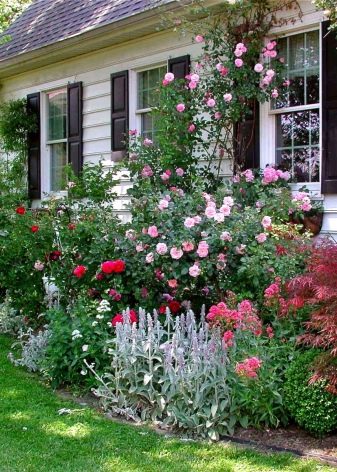
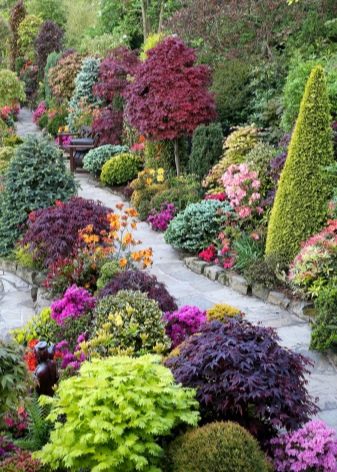
It is important to consider this feature here. All plants are located quite close to each other. Therefore, it is quite difficult to weed them. And it is impossible to water at once. After all, some green specimens love water, others not particularly.
But the picturesque view of such a flower bed will pay off all the efforts. It will not stop blooming from early spring to late fall. It is not for nothing that, as a rule, no vegetable beds are planted next to the mixborder. The flower garden serves the purpose of pleasure, so its best neighbors are, perhaps, benches, water bodies, beautiful lawns.

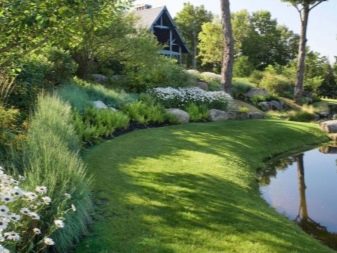
Views
The types of mixborder depend on which plants make it up. There are quite a few types, the most popular are the following:
- Lugovoi. The flower garden is as close as possible to the natural meadow in terms of the collection of plants. It is saturated with discreet, but graceful flowers such as wildflowers. The palette of colors is somewhat blurred, unpretentious. Flax, chamomile, poppies, forest carnations, bells, cornflowers are the main composition of a meadow flower garden. Plus decorative cereals for expressive design.
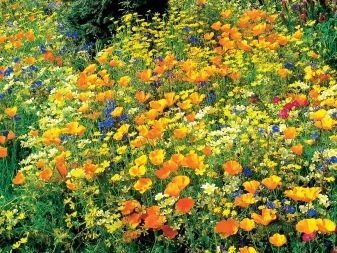
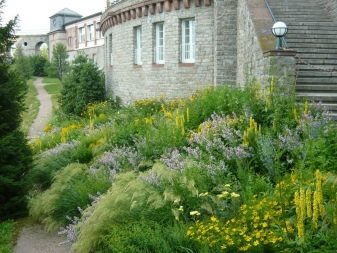
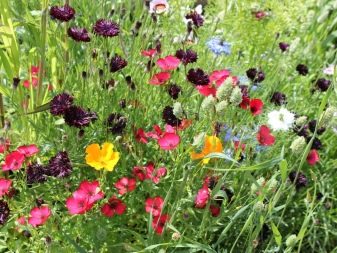
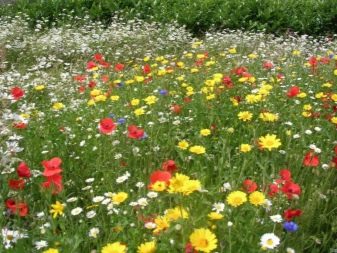
- English. The classic version, in some ways even strict. There are practically no magnificent forms and festive shades. Flowers are medium-sized, restrained, with graceful leaves. Pastel colors - pale pink, white, cream, pale purple. From flowers used small roses, daisies, undersized anemones, pale cineraria.


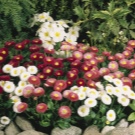
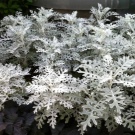
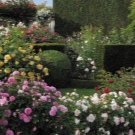
- Rustic. A very colorful and romantic mixborder, especially for lovers of country style, Provence. Consists of the most unassuming plants registered in the area. Sunflowers, viburnum, lupins, mallow, lavater, buttercups, heather and other "semi-wild" crops are suitable.
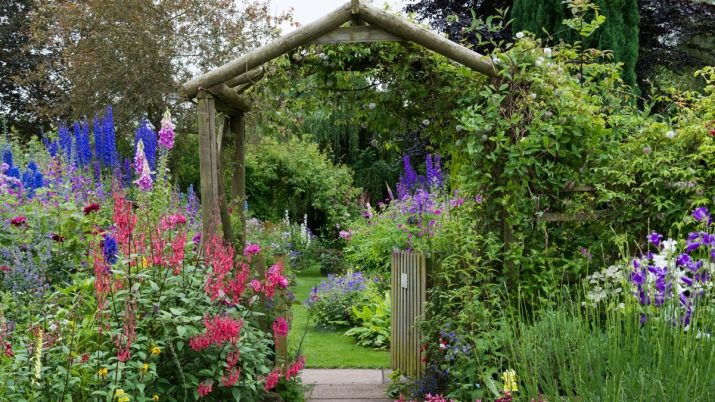

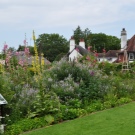
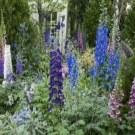
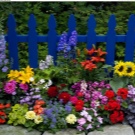
- Shadow. Only plants that feel good in a shaded space are selected.The flower garden turns out to be outwardly modest, with small and medium flowers, pretty shrubs. At the same time, it is aromatic and natural. You can collect cypress trees, yews, dwarf spruces, junipers, ferns here. Not fabulous, but very picturesque in a shaded mixborder rhododendrons, wolfberry, maidenhair, kupena, uvularia, periwinkle, whiteweed, waldsteinia, violet, saxifrage, hosts.
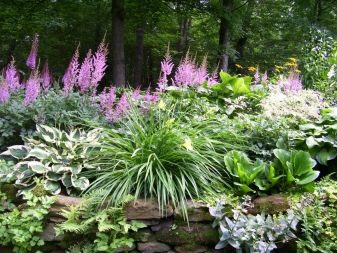
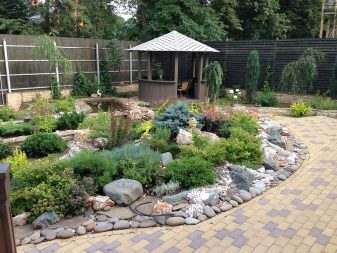
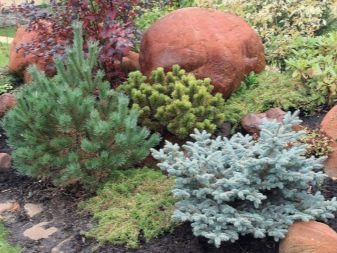
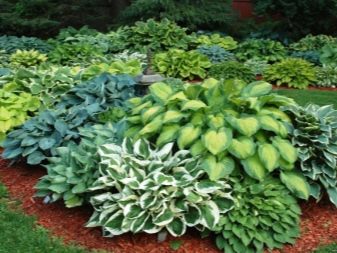
- Continuous flowering. TIt is better to split such a composition on a large free area. This type of combined mixborder includes representatives of the flora participating in the flowering relay for three seasons. For example, lumbago, styloid phlox, mertensia virginiana, lungwort, chionodoxa, crocus (spring), peony, dicentra, aquilegia, iberis, carnation, monarda, lily, Gaillardia (summer), aster, anemone, chrysanthemum (autumn).
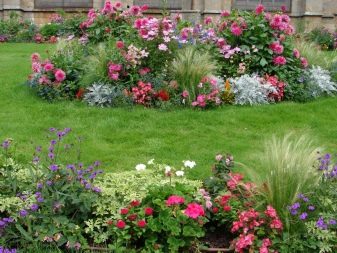
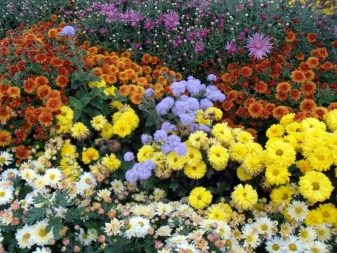


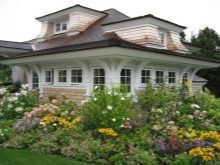
The main principle of creating a mixborder is that low-growing plants (up to 40 cm) are brought to the fore, medium-sized plants (up to 60 cm) are behind them, and high plants (a meter and above) are moved to the background. Also in the last row of the flower garden, trees, shrubs and climbing specimens plus cereals can be used.
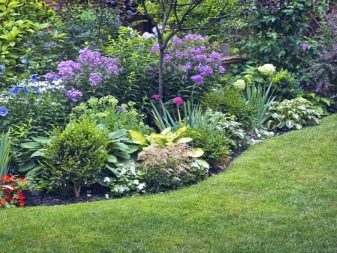
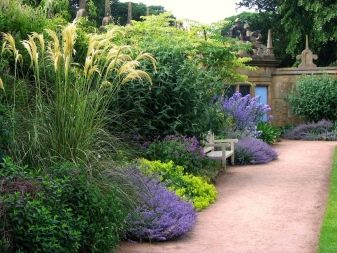
It is good if novice gardeners remember what mistakes must be avoided when forming a mixborder:
- plants cannot be planted at random, it is necessary to take into account their tolerance of the composition of the soil, wind, moisture;
- flowers with strongly growing rhizomes are unacceptable in the flower bed;
- do not plant dry-loving flowers close to each other and require constant watering;
- do not exclude greens from the mixborder collection, it will give it splendor and volume.

Dimensions (edit)
To determine the size of the mixborder, you need to do a little calculation. If your plot is spacious, the architectural elements are voluminous, the buildings are tall, then it is advisable to break the flower bed with a lush, long, saturated one. Analyze the size of the hedge, fence, which may be adjacent to the flower garden. For example, with a standard fence of 1.8 meters, the mixborder must be planned with a width of one and a half meters so that the fence does not visually hang over the flowers.
If the border for the flower garden is long, it should also be wide. Then the harmony of perception is achieved.
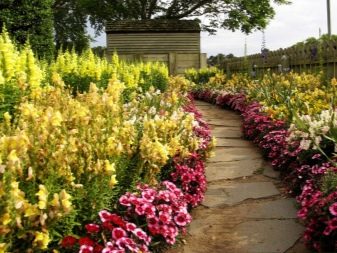
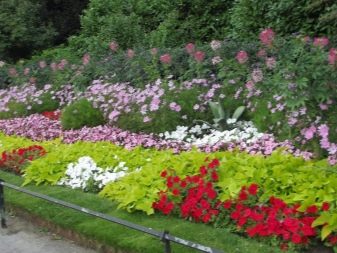
Well, if you are limited in space, then create yourself a mini-mixbrder in stones - it looks elegant and fresh. Dig in stones along the path or small flower bed, the stones should be only slightly larger than the plants in the mini-flower bed. Groups of stones can be interspersed with low (20-40 cm) terraces.
Flowers are placed next to the stones. It turns out that the flowers knock out from under the stones or "flow" from them. Nice and stylish, does not take up much space.

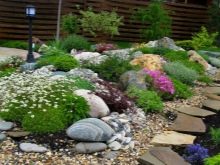
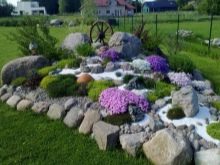
Color solutions
It is believed that even in the most colorful mixborder, five primary colors are enough, otherwise the harmony of colors will be replaced by bad taste.
The following color types are a kind of classic:
- Monochrome. The theme is played with shades of the same color. According to landscape artists, the monochrome version is not in the least flawed. On the contrary, it conveys the subtle creative preferences of the hectare owners. Plants in this delicate collection open up well, greenery brightly sets off the composition. True, if the monocolor is made white, then it will still be faded. But blue, red, yellow of all shades - a real poetic splash at your dacha. Imagine a "bouquet" of delphiniums, forget-me-nots, bells, crocuses in their palette from dark blue to sky blue - beauty!
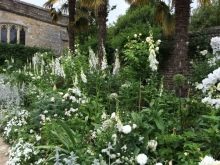
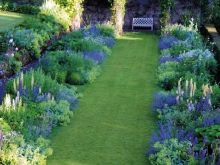
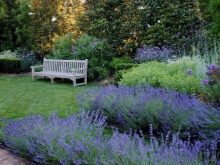
- Contrasting flower garden. The palette fantasies are built on opposite tones and semitones. But such an extravagant technique is good for small compositions. A voluminous mixborder red-yellow-blue "mishmash" will bring to pretentiousness. So, interrupting with hosts and ornamental cereals, we plant in groups scarlet dahlias, blue aquilegia, yellow escholzia, purple montbrecia, raspberry echinacea.Each variety in a group and a lot of greenery with a silvery tint - it will turn out festively and not prohibitively bright.
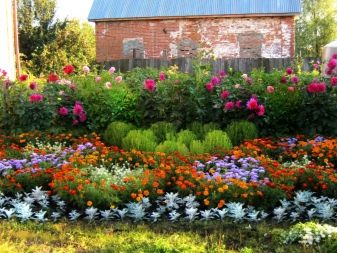
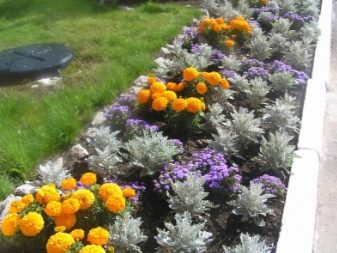
- Polychrome mixborder. About a third are brightly colored plants. The rest are calm. It is better to build a composition on matching shades - for example, lilac, burgundy, white, hot pink, cream, bronze, mustard, olive.
- There is also the concept of a tinted flower bed. For example, flowers of lilacs, roses, irises, lilac phlox will look romantic, smoothly "passing" into each other. You can make the tint version more expressive. Let's say, "fiery passion": a drop of red and yellow colors, terry asters and gerberas.
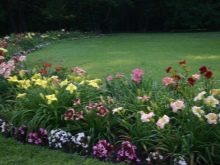
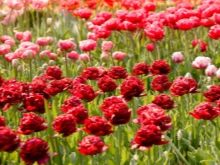
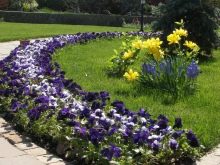
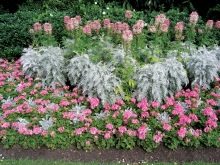

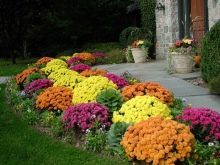
Device and location
When choosing a place for a flower garden, you should understand that areas of high dampness, solid shade or open space under the scorching rays are not suitable for it. It is best to set aside an area for the mixborder where there is room for both the sun and partial shade: on the slope, along the fence, near the house. The flowerbed will look good along the edges of the terrace, along the perimeter of the suburban area, near the path.
In general, it would be right to create a project for a future mixborder. If you want to break it under the windows, then everything must be planned so that the plants do not end up above the window openings. If you choose the option along the path, then step back at least half a meter.
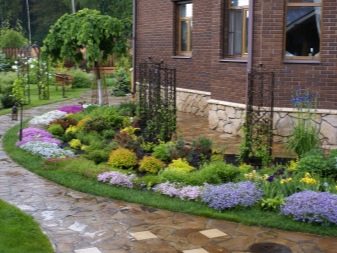
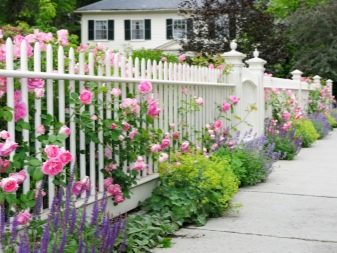
It is possible to successfully form a complex flower garden around the perimeter with your own hands, subject to the intermittent pattern of the mixborder. Because otherwise it is difficult to achieve such an arrangement of plants when they do not overshadow each other. After all, the design is unique in that the flowers in the group are placed freely, as if flowing into each other. This naturalness is wonderful for a free flower garden.
The construction of a flower bed scheme should proceed from the fact that the mixborder does not seem to accept straight lines. Its landmark is a wavy border, the more "waves" along the edges, the more attractive the mixborder.

That is, the correct arrangement of groups of plants in your natural flower bed is the rule of the golden ratio: one whole is divided into two parts, while the smaller part is related to the larger one, as is the whole. Simply put, the volume is broken down into certain parts. In a flower garden of a natural character, undulating segments are its main charm and dignity.
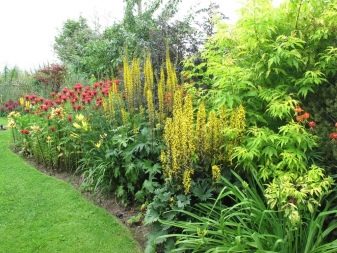
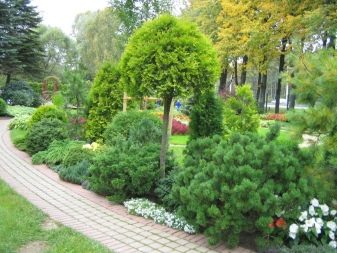
Another important detail. The largest floristic specimen of a flower garden should not be more than half of the entire length of the flower bed. Otherwise, you will not achieve a full view of the splendor that you have planned.
Selection of plants
Europeans have long confessed their love for mixed flower beds of arbitrary formation. The Russians are just getting started, but mixborders are clearly in trend. Largely - thanks to the art of combining different plants in an absolutely fancy assortment.
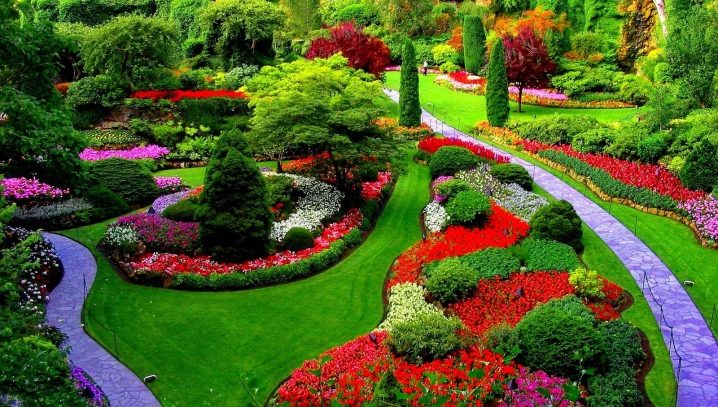
Designers promote a huge number of ready-made planting schemes and plant names in such a flower bed. Mixborders from ornamental shrubs and conifers look original. Conifers are better to pick up low, up to one and a half meters. Dwarf pine and fir will perfectly fit into such a composition. Add to these a columnar thuja and a pyramidal juniper. The austere shapes of these trees make your plantings a real masterpiece.
And for color, "splash" barberries and rhododendrons to the conifers. These flower and shrub cultures will set off the dark green needles of tree species with their orange, crimson, yellow-red tones. To achieve a more luxurious flower bed, you can prescribe heather bushes in the front row, flashing with raspberry garlands during flowering.
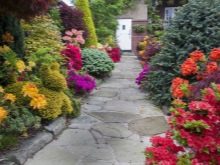
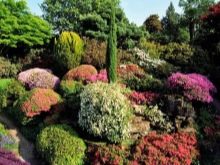
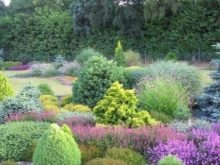
As for the mixborder of flowers, they are divided according to their functionality into skeletal and all the rest. The first denote accents, the basis of the meadow. The latter fill the space. Skeletal plants should be showy, with large leaves and flowers. Try to push them further into the background.Choose the range you like for these purposes with dahlias, hydrangeas, astilba, delphiniums.
Skeletal color concepts are given different meanings by designers. Some harmoniously weave them into a common flowerbed as “elders”. Others believe that the "skeleton" is just a kind of frame, a rod on which the flowers of the common array are "strung". The second concept involves the use of jasmine, park roses, and red-leaved plum as skeletal plants.

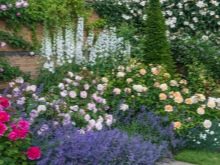
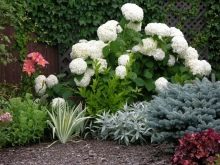
Well, the middle tier, depending on the height of the flight of the designer's imagination, is filled with perennials or annuals, blooming for a long time and brightly. This is, for example, a "bouquet" with yellow daylilies, frintillaria; phloxes, pennisetums.
Low-growing plants in the foreground can also be selected in a free format. If we proceed from the assortment of unpretentious ones, then petunias, cineraria, heuchera, tunbergia, geraniums are suitable. Their petals and leaves are bright, juicy, it will turn out solemnly and elegantly. As a folk note, you can add a little ornamental grains: sedge, barley, feather grass and hare tail.
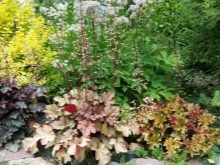

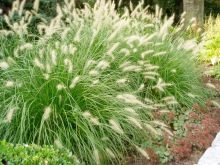
Not so often, but among summer residents there are lovers of vegetable flower beds. It's easy to create them, you don't just have to plant everything, so as not to get a stupid garden bed that can be eaten by the fall. "Soloists" in a vegetable mixborder - salads, lacy herbs, ornamental cabbage.
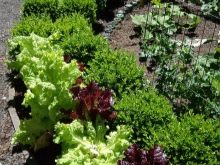
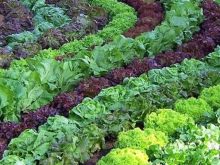
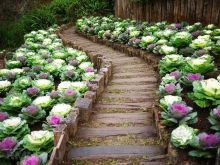
Add chard to such a unique accent. And make the border of the vegetable mixborder from flowers - tagetis, petunias, calendula. It will look very original and impressive.
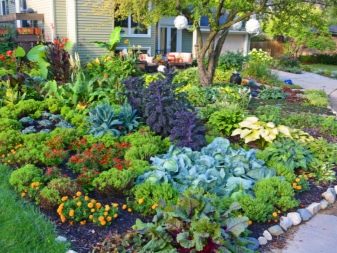
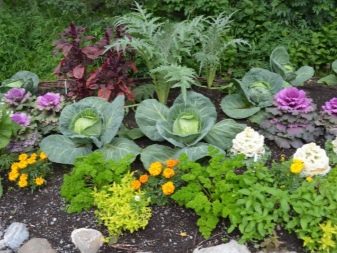
Care
When compiling a mixborder, it is imperative to exclude aggressive plants that grow rapidly and clog neighbors. It is necessary to place each type of flower or shrub at some reasonable distance from each other. Otherwise, the plantings will not be approached when watering and weeding.
It is worthwhile to provide stones and or small areas in the thick of the mixborder so that you can stand on something to weed, remove dried flowers and leaves. For the same purpose, it is convenient to lay a narrow path on the non-parade side of the mixborder.

A practical maintenance measure is to add flowers and herbs that the pests are afraid of. These are thyme, nasturtium, wormwood, cilantro.
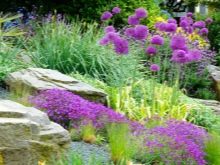
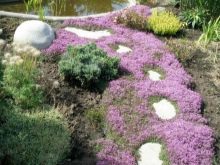
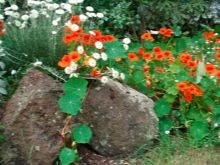
Beautiful examples in landscape design
Among landscape designers, there are many fans of the mixborder with a fountain. It is truly mesmerizing. Especially if the viewing angle is such that the fountain is viewed from different positions, and each time it looks in a new way in a round dance of flowers. Place the artificial fountain in the middle of the lawn, along the edge of which to arrange a flower garden. Such a corner will become a mesmerizing place in your country house.
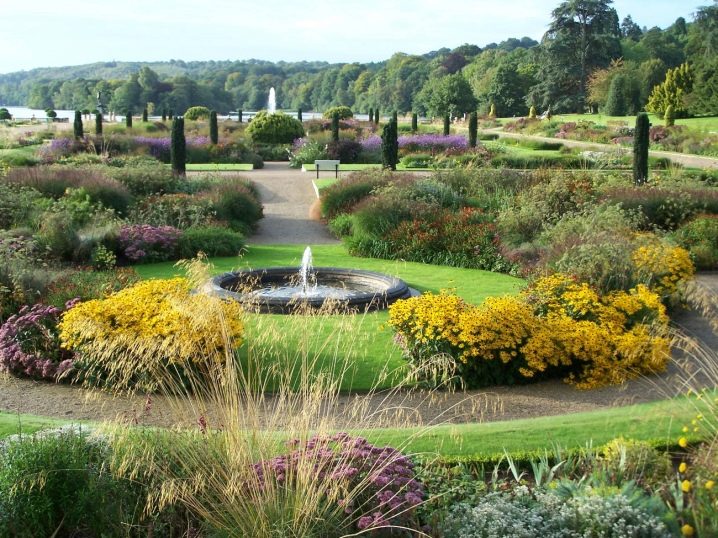
Artists of country gardens suggest adding expressiveness to the composition, framing it with tiles, colored sand, light cobblestones. An incredible, unexpected effect is given by low lanterns, "snatching" the most beautiful fragments of the flower bed. It is not enough words to reproduce the feeling from the night contemplation of such a flower serenade.
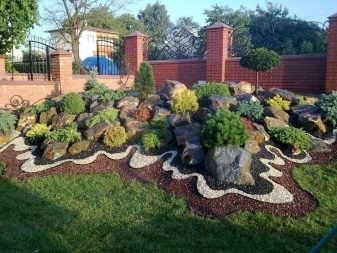
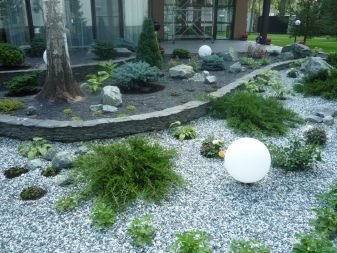
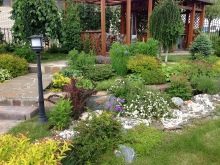
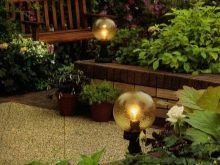
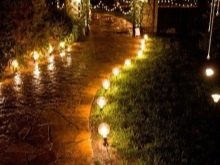
Lovers of exotic can insert exotic specimens in pots into a free flower garden in places free from seasonal plants. They will look shocking in combination with the flowers of the middle climatic zone of azaleas, oleanders, orchids in flowerpots.


Today mixborders are intensively complemented with garden sculptures and mountain boulders. The flowerbeds are "wound up" in the rear rows on props and lattices, where they organize screens of climbing perennials. In a composition with arches, all kinds of artificial slides, mixborders also win.

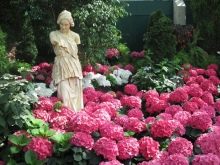
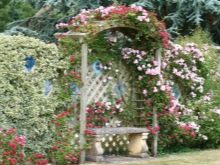
However, it is worth constantly focusing on a sense of proportion, so as not to bring the cute idea of a summer cottage meadow to the absurdity of boundless decoration in the pursuit of unusualness. In experienced hands, a mixborder is, of course, a winning card for turning an ordinary site into a heavenly place.It will turn out to be not an easy and expensive business, but the opportunity to enjoy a river of flowers near a country house from spring to autumn will pay back the costs many times over.
For information on how to make a mixborder from tall, simple annuals, see the next video.



































































The comment was sent successfully.